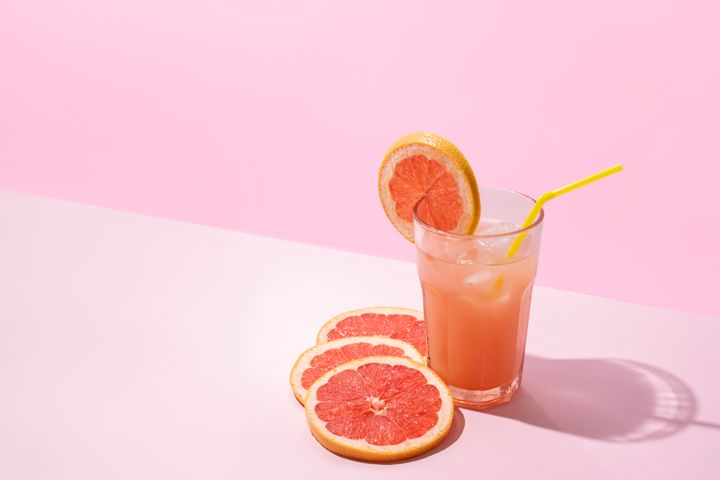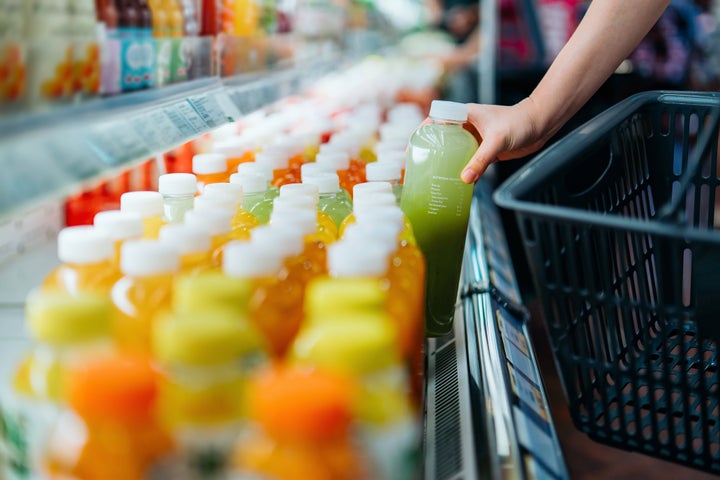
If there’s one piece of nutrition advice most people don’t need to hear for a millionth time, it’s that soda is bad for you, and the only thing you should drink when you’re thirsty is water. If you’ve spent enough time in fitness or “wellness” spaces, you’ve probably heard about how bad fruit juice is, too — at least, supposedly. But given that even the most processed, big-brand juices out there are made with some amount of fruit, it’s hard to imagine that fruit juice is nutritionally on par with, say, Coca-Cola.
As with pretty much anything relating to human health, there’s a little more nuance to the picture than simply “fruit juice = bad” (or good, for that matter). Most registered dietitians will flag the sugar content of juice as a drawback, and encourage their patients to get their hydration primarily from regular old water. But at the same time, there are downsides to completely vilifying an entire category of food or beverage, particularly for folks who are prone to restricting or other forms of disordered eating.
We spoke to a handful of nutrition experts who shared their guidance on exactly how fruit juice affects the body, and what juice lovers should know.
Not all sugar contents are created equal.
“Fruit juice is essentially water, sugar, vitamins and minerals,” explained Jami Zimmerman, a clinical registered dietitian at NYC Health and Hospitals/Bellevue. She, as well as the other professionals we spoke to, all emphasised that the sugar content is what makes juice a less-than-perfect beverage.
“Juicing removes all of the fruit’s fibre content, which aids in blood sugar regulation and satiety, which is the feeling of fullness after a meal or snack,” Zimmerman said. “The combination of no fibre and high sugar content makes for a high-calorie beverage that is easily over-consumed and can contribute to excess calorie intake,” she added.
Over time, this can affect your weight, which in our size-obsessed society is probably why you’ve heard the “juice is bad” maxim before. But it’s not just a matter of vanity; in the shorter term, it can make you feel … just kind of crappy.
“When consumed alone,” Zimmerman said, “fruit juice can cause a rapid blood sugar spike, followed by a crash that can lead to increased hunger and fatigue due to the sugar being rapidly absorbed by the body.”
Of course, people with diabetes or other blood sugar-related conditions need to be cautious about their sugar intake, and should work with their doctor to determine if and how fruit juice can be suitable to their health needs. But no one is immune to the dreaded sugar crash, so regardless of whether or not weight is a concern, it’s worth paying attention to how drinking juice makes you feel throughout the day.
Are the rules different for kids?
In the case of children, there’s another reason to limit juice consumption. “When we’re talking about kids, [juice] often makes kids really full. So we want to think about when, say, they’re drinking too much, they often miss the opportunity for other, more nutritious foods,” explained Ayelet Goldhaber, a dietitian/nutritionist at NewYork-Presbyterian/Weill Cornell Medical Center.
If you’re a parent or other kind of caregiver, you’ll want to make sure that the little ones aren’t drinking so much juice that they’re too full to eat their broccoli when dinnertime rolls around. Goldhaber also suggests not giving kids juice before age 2 at the earliest.

If it comes from fruit, doesn’t it have good health benefits?
But if there’s a little voice inside of you that’s screaming, “It comes from fresh fruit! It can’t be all bad,” you can go ahead and tell her she’s not wrong, exactly. Juice is lacking the fibre present in whole fruits, but it does carry some of fruit’s other nutrients. (And no, orange juice with pulp still doesn’t have enough fibre to meaningfully counterbalance the sugar content. We asked.) As Zimmerman notes, juice can be a good source of vitamins A and C, potassium and other micronutrients, depending on what it was made from and if it was fortified. And of course, because of its water content, juice does provide hydration.
What kinds of juice are the healthiest?
“OK,” your little voice might be saying, “but the kind of juice has got to make a difference, no? Aren’t some juices healthier than others?” The answer, it turns out, is a big “sort of.” It’s true that there are going to be differences in the nutritional profiles of, say, a cold-pressed green juice and a jug of Minute Maid fruit punch. Dr. Melanie R. Jay, associate professor of medicine and population health at NYU Langone Health, illustrated some of those differences.
“Tomato juice generally does not have as much sugar” as sweeter, fruitier juices, Jay said, “although you do have to be careful of added salt and high sodium content. Cold pressed green juice is generally made from greens such as zucchini, spinach, cucumber, kale, with some fruit mixed in — so it has less sugar. Certain juices you purchase in the stores can have added sugar, food colouring, and not as many nutrients.”
Zimmerman echoed this, encouraging people to check not just the sugar content, but specifically the “added sugar” content that nutrition labels now require brands to disclose. “Fruit juice is already sweet, and grabbing one with added sugar can lead to a larger amount of calories with no added nutritional content,” she said.
But while some juices certainly offer more nutrients and less sugar than others, the “no fibre, all sugar” problem still applies pretty broadly. Cold-pressed juice, because of the way it’s made and shipped, may sustain more nutrients by the time you crack it open than more processed kinds of juice. But even the most vitamin-packed, corn-syrup-free juices can still spike your blood sugar. The experts we spoke to don’t really consider one to be dramatically better than the other.
“In short, both fruit juice from grocery store shelves and cold-pressed juices are very comparable in nutrient profile and effects,” Zimmerman said.
There’s no need to entirely banish juice.
Still, juice can have a place in a healthy diet. While nutrition experts generally won’t recommend it as a primary source of hydration, most will agree that it’s fine as a once-in-a-while treat. And, as Jay said, it’s “definitely preferable to soda.” In some cases, juices can be a convenient and practical source of nutrients that a person might not be getting elsewhere in their diet.
“Some of my patients will not eat greens any other way,” Jay said, “so it can be a way, albeit expensive, for them to get nutrients from plants.” If this is you, seek out juices that are made mostly from green vegetables and with minimal sugar. Actually, when buying any juice, an ingredient list of real fruits or veggies (preferably 100%) and a low sugar content are key traits you should seek. Just be sure you’re looking at the specifics on the nutritional label, not so much the marketing copy printed on the front of the bottle.
“Brands frequently use the term ‘natural’ to describe their products,” Zimmerman said, which is typically meant to imply that it’s a healthy drink, or at least healthier than its competitors. But she cautions that that’s not necessarily true.
“In the food industry, the term ‘natural’ currently has no regulations, meaning it does not imply any specific processing standards and is strictly a marketing term used to entice consumers,” Zimmerman added. “Products claiming to be ‘natural’ can still have identical effects on the body as a product without that claim.”
Limit yourself to one serving per day.
But in addition to picking high-nutrient, low-sugar juices, nutrition experts still recommend minimising your juice intake to a single serving (about 8 ounces). If that sounds difficult, there are a few compromises you can make to cut down on your sugar intake without giving up juice entirely.
Eating your fruit whole and unadulterated is preferable, but if you need them in a drinkable format, consider swapping juice for smoothies made from fresh fruit. That way, Goldhaber says, you’re still consuming the fibre from the fruit and thus your body won’t absorb the sugar as rapidly. “It’s really a win-win,” she said.
If you drink juice primarily for hydration, e.g., because you don’t like the taste of water, Jay suggests weaning yourself off sugary beverages gradually by giving your palate time to adjust.
“I would recommend diluting the juice with water or seltzer/club soda and slowly increasing the ratio of water to juice over time.” When she offers this advice to her patients, they often discover to their own surprise that in a few months’ time, “they much prefer the taste of the diluted juice and find they only need to drink one part juice to three parts water to get the same satisfaction.”
Help and support:
- Beat, Adult Helpline: 0808 801 0677 and Youthline: 0808 801 0711 or email help@beateatingdisorders.org.uk (adults) fyp@beateatingdisorders.org.uk (youth support)
Samaritans, open 24 hours a day, on 116 123
Mind, open Monday to Friday, 9am-6pm on 0300 123 3393